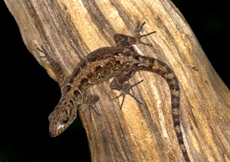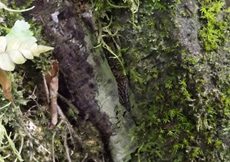Gonatodes ceciliae
(DONOSO-BARROS, 1966)
Distribution:
Northern Venezuela, Trinidad
Description:
Gonatodes ceciliae is one of the largest species of the genus Gonatodes. While it is written, adult males have an overall length of 14 centimeters, I can only report adult males 12 centimeters in length, in my collection. The females of Gonatodes ceciliae remain somewhat smaller, with a total length of up to 11 centimeters. At first glance, it is easy to confuse the females of Gonatodes ceciliae with those of the species Gonatodes ocellatus, as their base colors are quite similar. Gonatodes ceciliae females however, are brown-beige, with a mottled pattern. Over their entire back is a beige colored band, which is interrupted by a plurality of transverse bands of gold, which taper towards the abdominal region. Males are colored significantly more spectacular. While their base color is brown-beige, there are countless bright red and yellow specks throughout their whole body. The golden bands displayed on the females, are also found in the pattern of males. Regenerated tails of males, are red.
Habitat:
Not much is known about the natural habitat of Gonatodes ceciliae. Descriptions range from an extremely high sensitivity to direct sunlight, resulting in overheating, or sensitivity to high humidity. More trips to their natural habitat will be needed, before we can make final statements about their habitat. With us in captivity however, we have found Gonatodes ceciliae to be extremely adaptable.
Husbandry and Breeding:
I keep my Gonatodes ceciliae pair in a terrarium measuring 30x30x45 centimeters and feel nothing smaller should be used. The rear wall of the terrarium features a design constructed on my own, which the animals use very extensively. Branches and small plants are also featured throughout the design.
In summer the terrarium is kept at 32°C (89.6°F) daily, with a drop to 23°C (73.4°F) during the night. In winter the terrarium reaches 28°C (82.4°F) daily, with a nightly drop to 20°C (68°F). The terrarium is illuminated for 14 hours per day, with a 35W Solar Raptor Lamp (Combo Lamp: Heat + UVB). Thus, the required heat and UV amounts are guaranteed. I could never observe my pair sunbathing, however, I have provided them with the flood version of this lamp regardless, so they may do so if they choose. The animals, in my opinion, display increased colors under UVB lamps.
The humidity of the terrarium is kept between 70-80% by spraying the terrarium up to 3 times daily. I have not placed any additional water in to the terrarium for the animals to drink freely, due to the misting frequency.
I mainly offer my pair Drosophila and small crickets. All food is dusted with the appropriate supplements.
In a heavily vegetated enclosure, I could almost never see the male in my enclosure. The female was observed when the two sexes clashed and she was trying to escape. The male would usually use his tail in a whip like fashion often to display his state of mind, this was especially observed during hunting, or threats.
Often I would observe the pregnancy of my female, but could never find the eggs until one day I saw a baby running frantically through the enclosure with the parents right behind in order to use it as a tasty snack. When searching further, I found a relatively large cave dug by, I assume the male, which not only seemed to be used as a permanent shelter by him, but the presence of 5 eggs. I removed the eggs at once to an incubator where remaining young were left to hatch out freely away from the parents. I kept the incubation temperatures at 26°C (78.8°F) daily and 21°C (69.8°F) at night. This provided to be beneficial in obtaining more females. The incubation periods however, varied so widely, that I cannot at this time provide more accurate time frames.
In a more lightly planted terrarium, the aggression between the pair vanished, no new cave was created and the eggs were laid more openly, or in a small pit, which was then covered again. The young animals of different ages were raised together in a relatively identical terrarium to the adults, along with the same type of illumination. At first which I noticed a lot of shedding problems due to the large amount of UVB exposure. This was later solved within 1-2 months of no direct UVB exposure.
The young are relatively large when emerging from their egg, so their food is also pretty similar to the adults, with the addition of springtails or small woodlice, but is not absolutely needed.
While Gonatodes ceciliae can generally be quite shy, you must give them a bit of time and peace to explore the terrarium, after which they will become a little more open. Despite this, they still make a very desirable terrarium inhabitant.







